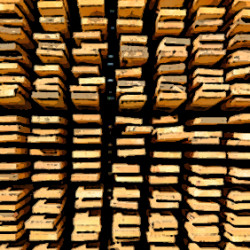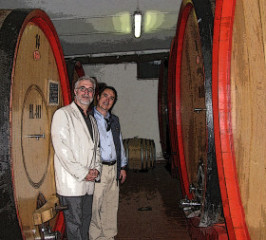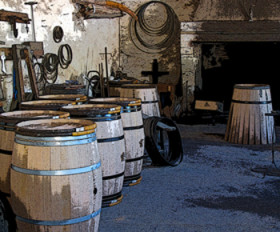When it Comes to Wood, Size Matters
Chapter Thirteen, Parts Three, Seven & Eight.
Different wine regions use barrels of varying size to fit their needs (and maybe their warehouses). The volume of the popular Hogshead barrel seems to vary with every industry, but for wine it has come to mean a 63-gallon barrel, while the uniquely named butt barrel holds two Hogsheads or 126 gallons. The winemakers of Bordeaux find a barrel holding 59.4 gallons is perfectly suited for Cabernet and Merlot based wines. In Montalcino, where tradition dictates that Brunello di Montalcino be aged in cask for three years, wine is matured in large Slovenian casks called botte, or the plural botti, a term presumably derived from butt (those are 6 words I never imagined myself writing). Smaller barrels have a stronger impact on wine, so most Brunello producers use botti because they feel three years aging in small casks would produce overpowering oak flavors in the finished product.
After several years of use, oak barrels are referred to as neutral because they lose their potency and deliver about as much flavor as dinner at a gluten-free picnic. Many wine regions, including Montalcino and Chablis, prefer neutral barrels because A. they mellow the developing wine through a slow, even oxidization, B. they no longer give off oak flavors, and C. the accounting department doesn’t lose sleep over the cost of new barrels.
Tis The Season
 Before coopers craft oak into barrels the fresh cut wood must be properly seasoned to reduce its impact on wine. Seasoning simply means the staves are left outdoors for up to three years, which also means my neighbor’s lawnmower has been properly seasoned. Repeated exposure to heat, cold, rain and snow creates a more controllable product by gradually leaching out the impurities, objectionable odors, and harsh green tannins that would otherwise overpower wine. Without seasoning, these compounds can create unpleasant sawdust-like attributes that can be more resinous, woody, and herbaceous than my brother-in-law’s stash bag.
Before coopers craft oak into barrels the fresh cut wood must be properly seasoned to reduce its impact on wine. Seasoning simply means the staves are left outdoors for up to three years, which also means my neighbor’s lawnmower has been properly seasoned. Repeated exposure to heat, cold, rain and snow creates a more controllable product by gradually leaching out the impurities, objectionable odors, and harsh green tannins that would otherwise overpower wine. Without seasoning, these compounds can create unpleasant sawdust-like attributes that can be more resinous, woody, and herbaceous than my brother-in-law’s stash bag.
Due to increasing demand for oak barrels, some cooperage houses have turned to kiln drying wood rather than the time consuming practice of air-drying. This process magnifies vanilla lactones, but a high percentage of astringent green tannins remain embedded in the unseasoned wood. After a few years the vanilla esters are depleted, leaving nothing but unpleasant green tannins behind to sully the developing wine.
American oak got off on the wrong foot with many winemakers who experimented with barrels that were quickly kiln-dried, bent with steam, and heavily toasted with a gas flame, rather than the traditional method of outdoor seasoning for years then bending and toasting the staves over a flame fueled by oak. These shortcuts were developed for American bourbon production where finesse is not required but a toasty vanilla flavor is. When winemakers realized these barrels were unsuitable for quality wine production, they blamed American oak rather than the process. The resurgence of American oak barrels in the past few decades is due to the movement away from these practices and towards traditional French cooperage methods.
To Tree, Or Not To Tree
Once a winemaker decides to flavor wine with oak, she has a botte-load of variables to consider. She has to choose the tree species and country of origin for the desired flavor profile. She must deal with a reputable cooper to assure the oak has been properly seasoned. She orders barrels with the desired toast level and then fills them with the product she has spent half a year nurturing. In the ensuing months, the angels take their share and the devil takes his cut. Wineries commit a lot of money and time to their barrel regimen, but here’s the kick in the hogshead; every barrel has its own unique personality. The same wine may be put into a hundred different barrels, but a few months or years later the wine that emerges bears the unique stamp of its individual barrel.
Despite the extensive research on the subject, there is no solution to the problem of oak inconsistency. The terroir of a given forest, the variables between the top and bottom or north and south sides of a tree, or an oak forest’s inclination to hybridize, all affect the flavoring traits of the individual barrel.
Barrel variation means some barrels will produce a superior wine. In fact, many reserve wines are nothing more than a selection of the best barrels. The yin to this yang (or is it the other way around?) is some barrels don’t live up to the winemaker’s standards and the wine has to be unloaded on the bulk market. Barrel variation isn’t of much concern to large wineries where averaging equalizes the good and bad barrels, but for the winemaker who took out a second mortgage to purchase a dozen barrels it can have nerve-racking consequences.
In the end, winemakers must strike the balance of oak, fruit, tannin, acidity, and alcohol that pleases them. Our challenge as wine drinkers is to find the wines that strike the balance of oak, fruit, tannin, acidity, and alcohol that pleases us.






















